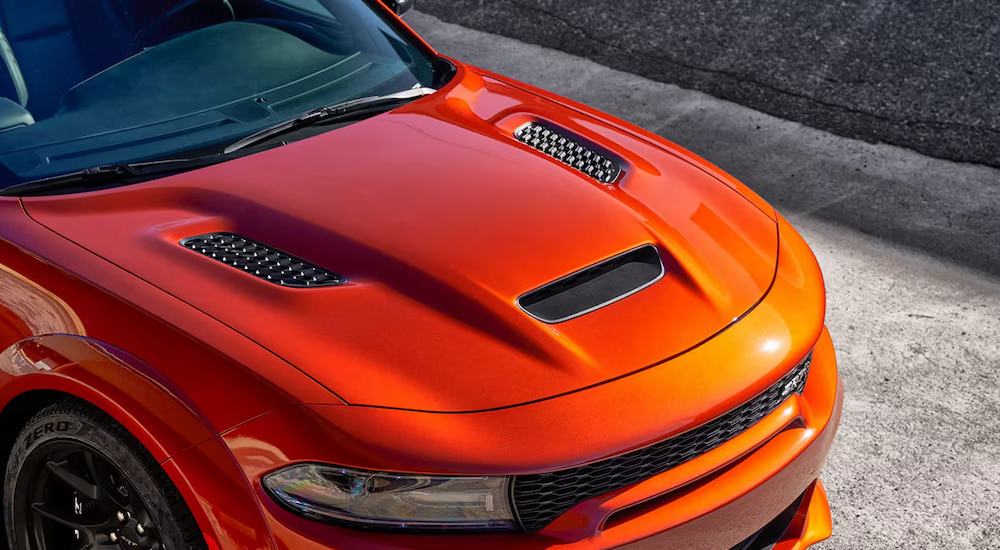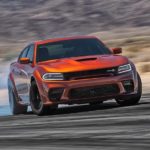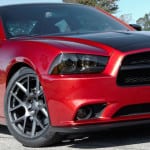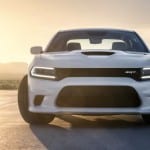The reports of the Charger’s demise were greatly exaggerated. While the iconic muscle car did take a brief hiatus from Dodge dealers for 2024, it’s back and better than ever. What a difference a year makes. Dodge has redesigned nearly every aspect of the Charger while folding in some classic features that are sure to drum up nostalgia among fans of vintage muscle cars. A pistol-grip shifter and layered dash design harken back to the Charger’s earliest days, but it’s still a thoroughly modern model with the addition of contemporary tech like a 12.3-inch infotainment display, Amazon Alexa voice assistant, a 16-inch digital gauge cluster, and an 18-speaker Alpine audio system. The Charger also looks every bit a muscle car with upsized air intakes, an aggressive new front bumper, and a body that just radiates speed.
All these styling and tech upgrades aside, a muscle car like the Dodge Charger will always be measured by one metric above all else: performance. There are plenty of changes on that front as well, with Dodge embracing some exciting new technology to keep the Charger relevant in an ever-changing market. The 2024 model year marks the debut of the all-electric Charger Daytona, but there is also a new gas-powered model for the eighth generation. Gone is the HEMI V8, replaced by an innovative new twin-turbocharged setup that Dodge has dubbed the Hurricane. A little forced induction goes a long way, with the new Charger beating its predecessor in terms of both performance and efficiency. So, how powerful is the new Hurricane engine, and how does it compare to the HEMI V8 found in the outgoing seventh-generation Charger? Let’s get behind the wheel of one of Dodge’s most thrilling rides and see how the Charger has evolved from a performance perspective.
Seventh-Generation Charger (2011-2023)
The seventh-generation Charger was a fitting swan song for the muscle car’s long-serving HEMI V8. The legendary engine allows every Charger owner to feel like they’re rounding the banked curves of their favorite NASCAR track, especially when opting for the high-performance beast that is the supercharged 6.2-liter Hellcat engine. With up to 807 hp and a class-leading 707 lb-ft of torque, the 2023 Dodge Charger SRT Hellcat, SRT Hellcat Redeye, and SRT Jailbreak trims offer a one-of-a-kind driving experience that can rocket you from zero to 60 mph in just 3.6 seconds. That’s on par with high-end luxury models like the Aston Martin Vantage, Mercedes-Benz SLS AMG, and Lotus Exige Sport 380 despite the fact that the Charger rings in at a fraction of the cost of some of these sporty imports.
The 392 HEMI V8 represents the seventh-gen Charger’s penultimate engine, and while it might fall short of the Hellcat’s horsepower, few drivers will find themselves underwhelmed by the 392’s resume. The 6.2-liter engine can churn out 485 horsepower and 475 lb-ft of torque with ease for a 3.9-second zero to 60 mph time, which makes it the second-fastest engine on offer. The 2023 Charger rounds out its HEMI roster with a 5.7-liter V8 that delivers 370 hp and 395 lb-ft of torque. Exclusive to the R/T trim, this engine excels in terms of both power and efficiency, with the included MDS Fuel Saver technology allowing the 2023 Charger to achieve 16 MPG in the city and 25 MPG on the highway. If you’re looking to experience the HEMI lifestyle without breaking the bank, the R/T makes a pretty compelling case for itself.
But the HEMI isn’t the only option for the seventh-gen Charger. Dodge also offered a 3.6-liter Pentastar V6 that is certainly no slouch when it comes to performance. Putting out up to 300 hp and 264 lb-ft of torque, the V6 still provides plenty of thrills while making the Charger a slightly more practical choice as a daily driver. The V6 wasn’t just the only engine in the lineup that could be paired with all-wheel drive; it was also by far the most efficient. This powertrain delivers an impressive 19 MPG in the city and 30 MPG on the highway, making the sedan’s SXT and GT trims a relatively eco-friendly option when compared to their HEMI-powered siblings.
Eighth-Generation Charger (2025)
Some purists might mourn the loss of the HEMI, but Dodge’s answer to the dearly departed V8 is, as some 1960’s folk icons might say, blowin’ in the wind. Debuting on the 2022 Jeep Grand Wagoneer and also making its way into the refreshed 2025 Ram 1500, the 3.0-liter Hurricane is a twin-turbocharged inline-six that offers V8 power without any of the downsides that can come with such a large engine. It’s not only more powerful than the outgoing 5.7-liter and 6.4-liter HEMI options, but Dodge says it’s also up to 15 percent more efficient.
The Hurricane is offered in two distinct forms: a Standard Output (SO) model and a High Output (HO) variant. Details are still a little hard to come by, but we know that the SO will offer a potent 420 hp while the HO ups that figure to 550 hp. The eighth-gen model also comes standard with all-wheel drive and a crisp eight-speed automatic transmission that should allow the I-6 engine to get you up to speed faster than a level-five twister. Torque figures are hard to come by at this time, but we do know that the Hurricane is able to produce as much as 521 lb-ft when it’s plopped under the hood of the 2025 Ram 1500. Dodge says the Hurricane will give the Charger a “broad, flat torque band” that lets the muscle car offer 90 percent of peak torque all the way from 2,350 rpm to the redline.
This sort of power and efficiency is made possible thanks to a full suite of advanced automotive technology, from high-pressure direct fuel injection to the dual overhead camshafts with wide-range, fully independent variable valve timing and engine-mounted water-to-air charge cooler that features its own dedicated cooling circuit. A handy stop-start function maximizes fuel economy without any impact on performance, while a continuously variable displacement oil pump with an integrated scavenge stage minimizes the friction that can rob a driver of horsepower.
All these cutting-edge components aside, it’s the Hurricane’s twin turbochargers that really deserve all the attention. They say two is better than one, and that certainly applies to the Charger’s low-inertia, high-flow turbochargers. The twin-turbo setup can spin up to speed faster than one larger turbocharger, offering a quick boost that lets the 3.0-liter I-6 punch well above its weight from a performance perspective. An integrated water-to-air charge air cooler creates colder, denser air for the engine to work, while an electric coolant pump helps keep the turbocharger at the ideal temperature for maximum durability. When paired with the SO version of the Hurricane, these twin turbos offer 22 psi of boost while the HO maxes out at 26 psi.
A Fresh Take on the Classic Muscle Car
The more things change, the more things stay the same. Dodge might have packed some exciting new performance tech into the eighth-gen Charger, but it still remains the muscle car you know and love. The Charger gets some important upgrades from a comfort and convenience perspective––not to mention a stylish makeover that combines the best of the old and new––but the new Hurricane engine is the clear highlight when comparing the two most recent generations. A new turbocharged approach works wonders for the Charger, allowing it to surpass previous generations while delivering the sort of improved fuel economy that’s sure to pay dividends at the pump. That’s not to say the seventh-generation model is obsolete by any means. If you’re looking for the true HEMI experience and aren’t scared off by a vehicle that can pump out 807 hp, the supercharged 6.2-liter Hellcat represents a bucket list experience for any longtime Dodge fan. No matter which trim or year you opt for, one thing is for sure: you’ll never be bored when you’re behind the wheel of a Dodge Charger.






